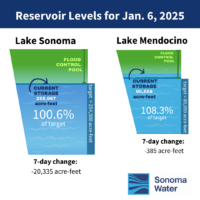
A view of Lake Mendocino. The lake will be 10,000 acre-feet below desired level by this fall. Submitted photo
According to the Sonoma County Water Agency, these three past months have been the driest spring on record – and the Sonoma County Water Agency is calling for conservation.
A mere .65 inches of rain fell between March and May – nearly three times less than in 2004, which, with 1.91 inches, held the previous record for the driest spring. This means that water flowing from the Potter Valley Project through the Eel River, and on into Lake Mendocino before getting released into the upper Russian River, has been reduced by 33 percent. “We rely on these sources for drinking water, wildlife habitat and recreational activities,” said SCWA’s Deputy Chief Engineer of Operations, Pam Jeane, in a statement by the Agency, which is calling for voluntary conservation. “Using less water means more water in the Russian River, Lake Mendocino and Lake Sonoma.”
Brad Sherwood, SCWA Public Information Officer, said the agency is carrying out an intense campaign for public information from putting newsletters in envelopes to making house calls and to their web page, “Less is More,” which explains the balance necessary to maintain a healthy ecosystem along with agriculture and municipal and personal use, and offers ten tips on water conservation. He wants to teach people to take advantage of rebate programs, to listen to conservation specialists, some of whom even make house calls. “Our goal is to change behavior,” he said. “We’re asking people to do what they did last year.” Last year, when the water agency asked for a reduction of 15 percent, the public responded and exceeded expectations. “They helped us reduce water from the Russian River by 21 percent,” Sherwood said. “Everyone stepped up to the plate.”
This year, the situation is plainly worse. “We are seeing a more severe projection,” said Sherwood. “The projection is 10,000 acre-feet less. If you looked at it as a scale of one to four, and one being okay and four being the worst, we’re seeing 3.5.” While there is no question that the need to conserve is urgent, since the public record has been so exemplary the plan at the moment is to ask for voluntary conservation – in the hopes that, with public cooperation, enough water will be conserved that mandatory restrictions will be unnecessary. The agency is able to monitor use day by day, and can tell how much needs to be pumped from the river into the municipal supply. For those on the outskirts of the city, on wells, conservation is still the word. “People on wells should also conserve, regardless,” said Sherwood, “because of how dry it is.”
Those using irrigation, such as grape growers, can help contribute to the conservation effort by using drip irrigation and by watering at night. “We’re working with Mark Greenspan, the viticulturist,” Sherwood said, “to set up a best management plan for growers. They responded very well and helped us achieve our goals last year, so we’re looking to build on that.”
The most pressing concern, said David Manning, SCWA Senior Environmental Specialist, is ensuring there’s enough water in the fall for the adult Chinook salmon to be able to make it up the Russian River past Healdsburg, toward Ukiah, where they spawn. This is not just a matter of preference or fish-fondness. It is a matter of law. “We have a dual mission, to deliver water and also conserve the environment,” he said. “In this day and age, we can’t pick and choose how we manage either for people or for fish; we have to manage it as an ecosystem. There’s really no separating them–especially in the minds of the regulating agencies.” He explained that the water agency’s work involves everybody, and needs everybody’s cooperation. “We supply water on demand. It would be easier for us to keep these flows for the fish. We don’t supply water to the agricultural users, but their withdrawal from the river has an impact on flow. Everybody needs to think about water conservation.”
The City of Sonoma has supported the concept of conservation, offering many residential programs to help families conserve and enacting an ordinance to require that all new construction be landscaped with water consciousness in mind. “Xeriscaping,” as it’s called, involves drip irrigation and plants that are drought tolerant. The Sonoma City Council on March 5 adopted an amendment to the Xeriscape Ordinance that requires all newly-constructed single-family homes to comply with the ordinance with respect to front yards. A drive about town reveals many lawns with sod rolled back, presumably sacrificed for greater water efficiency. The days of mid-day sprinkling are fading fast.
Sonoma Public Works Director Milenka Bates said what the city wants is for people to do what they did so well last year. “We’re really asking people to do it again. I’d really like to see everybody in the city to turn down their irrigation for a minute. Check for leaks: when you go to higher-efficiency appliances, you notice it in your water bill.” Drawing down local supplies is not the idea, she said, the point is to conserve. “Take advantage of the WaterSmart Home program. It’s free,” she said. “Brown is the new Green!”
City of Sonoma Water Conservation Program:
• Ultra Low-Flow Toilet Rebate – Get rebates of $100 per toilet for replacing your non-water conserving toilets.
• WaterSmart Home Program – FREE home water use evaluation and water saving recommendations. Call (707) 547-1910 to schedule an appointment.
• Water Conservation Fixtures – Free, high-quality showerheads, faucet aerators, hose nozzles and dye tabs are available at City Hall.
• Residential Clothes Washer Rebate – Go to www.conservationrebates.com for rebate amounts and qualifying models.
• Demonstration Gardens – Visit the garden to get ideas for low water use landscaping. Call to get directions and plant list for the two low water-use gardens.
• Cash for Grass Rebate – The City will pay you for removing turf and planting low water-use plants. Call (707) 547-1968 to get an application for this great program.




